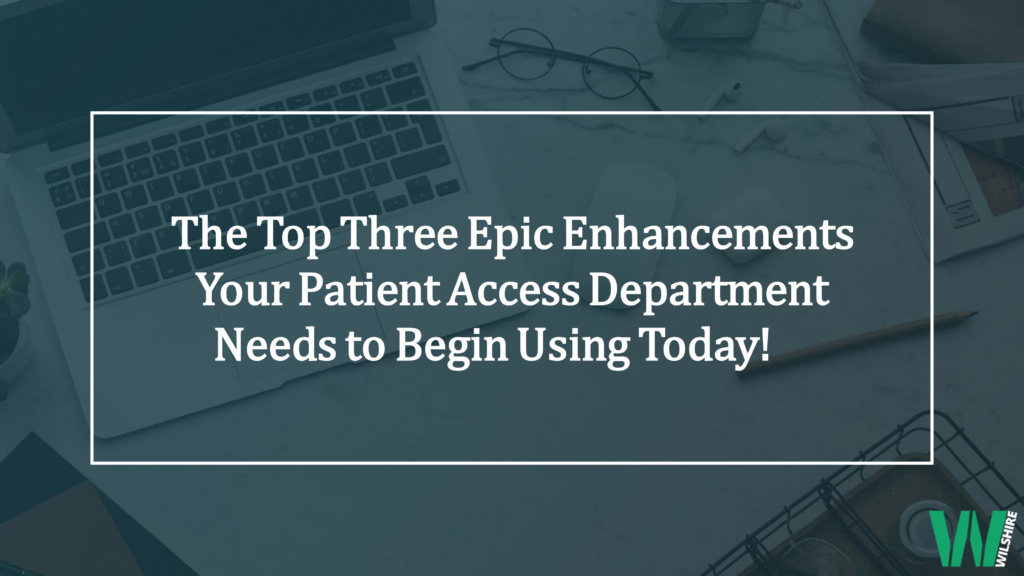There’s no doubt that the Epic Electronic Medical Record System is one of the most robust and forward-thinking EMRs available in the 21st century. Unfortunately, Epic is so robust that some of the most beneficial enhancements are either turned off, overlooked, or underutilized. This is especially true in Patient Access Departments. So, how would one know if Epic’s being optimally utilized?
This blog can help answer that question by assisting Patient Access Leaders in assessing their own Epic environments, identify some of the most beneficial enhancements available today, and serve as a guide to help turn these on in your organization. The following enhancements are a must at any health care system:
- MyChart E-Check In
- Automatic Plan Mapping
- Automatic Estimates
MyChart E-Check In
These very popular patient portal enhancements (that your patients likely already use and love!) can make several tedious tasks easier for both patients and health care facilities. From provider messaging to patient payments, having the capability to interact with health care professionals in the palm of your hand greatly improves a patient’s experience. MyChart’s E-Check-In is no exception and will revolutionize your department’s patient throughput processes by shortening patient arrival processes by 50% or more. Key things to consider in your build include allowing patients to perform the following:
- Demographic changes or updates
- Insurance changes or updates
- Patient payments (both for pre-payments and existing balances)
- Electronic consent capture
- Location-based arrivals
- QR Code generation (when scanned at arrival, patients immediately check in and bypass registration)
Depending on the current state of your MyChart environment, some of these items will be easy to activate, while others could require some extended build times. Items such as demographic and insurance updates are likely available today and will not require much attention. Other items like location-based arrivals, QR codes, and E-Consent Capture will need attention from both build and operational stakeholders. On a scale of 1-5, the effort involved with this build: 3/5.
Automatic Plan Mapping
Looking for something that can increase insurance plan code accuracy and decrease unnecessary eligibility/registration denials? Epic’s Automatic Plan Mapping is the enhancement for the job! It is important to note that for Plan Mapping to function properly, you may require some extensive build within your RTE and plan codes/ASA Table environments. It is also important to have a strong relationship between your IT and Operational departments since you will need a large amount of cooperation to make the project successful.
Once the build’s complete, Auto-Plan Mapping can review a payer’s RTE response, identify the exact plan the patient has, and update the coverage on the patient’s account. Removing (or at the very least, reducing) user error at the point of insurance creation will have a profoundly positive impact on registration and eligibility-related denials. 1:1 Plan Mapping is a must for the enhancement to function correctly but be prepared for continued review and maintenance on at least an annual basis. If you have a contracts or managed care team, they can likely assist by making you aware of new products or changes to existing payers. Since patient insurance plans and provider contracts are constantly changing, revising or terminating, your organization must be prepared to update the necessary components to account for the various changes. Build effort: 4/5
Automatic Estimates
Patient estimates have had a tremendous impact in healthcare and, when done correctly, patients have a much clearer idea of what to expect. Healthcare systems can also substantially improve POS collections practices and metrics by removing some steps at the point of registration. Setting up and deploying automatic estimates again requires some significant build, but the ROI for the effort is substantial, apparent, and immediate. Most organizations struggle with adequately training staff on how to create accurate estimates, while others struggle to finalize an estimate and subsequently attempt to collect. Estimate automation will simplify the requirements for the end-user by prompting them to simply review and finalize what is essentially ready for the patient. Ultimately, a higher Estimates to Patient Encounter ratio will result in higher POS Collections for the organization.
As with Plan Mapping, it can require continued maintenance over time. Estimates are only as good as the build behind them and as insurance plans change, the estimate build must be ready to adapt. You will need constant (at least quarterly) monitoring of finalized estimates for both functionality and accuracy to ensure optimal performance. To confidently audit estimates for accuracy, look back at least two months to determine how close a finalized estimate was to the patient’s actual billed amount. A good way to determine accuracy is if the estimate is within 10% of the actual amount owed by the patient. Build effort: 5/5
How We Can Help
Epic customers already have an advantage when caring for patients, but because there’s so much functionality within such a system, it can require more bandwidth, expertise and workhours than are available. The Wilshire Group can help bridge that gap and would love the opportunity to talk through your current Epic environment and how we can help your organization succeed with these enhancements! Visit our website to learn more about our patient access services or contact us for more information.

